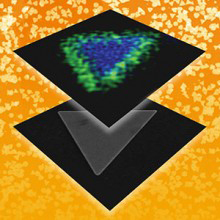Light Strikes Gold to Create Better Catalysts
A photochemical process yields precisely controlled gold nanocrystals for industry
(August 2016)

A photochemical strategy enables synthesis of gold nanocrystals with desirable properties for industrial and medical applications.
Tiny particles of gold are highly stable and have other attractive features suitable for use in certain industrial applications. However, it's been difficult to control the size and shape of single-crystal nanostructures. Recently, scientists revealed a specialized strategy that lets them synthesize a plethora of hexagonal or triangular gold crystals. The research team is from the University of Florida, Brookhaven National Laboratory, and Pacific Northwest National Laboratory.
Why It Matters: The study reveals a key role for a surfactant called polyvinylpyrrolidone (PVP) in the growth of gold nanocrystals upon exposure to visible light. The findings could be used to optimize properties of gold nanocrystals for specific applications.
Methods: A team of researchers revealed a photochemical strategy that enables growth of gold nanocrystals with controlled properties. The researchers found a high yield of hexagonal or triangular gold nanoprisms can be obtained by mixing organic polymer PVP in an aqueous solution containing gold nanocrystal seeds and tetrachloroauric acid (HAuCl4).
To understand underlying mechanisms, researchers probed the spatial distribution of PVP molecules on individual gold nanoprisms using nanoscale secondary ion mass spectrometry at EMSL, an Office of Science user facility. They also used EMSL's scanning probe atomic force microscope (AFM) compound microscope as well as the dynamic force AFM.
Surprisingly, the results revealed PVP preferentially adsorbs onto defects along the perimeter of the gold nanocrystals instead of the top and bottom facets as previously suggested. Upon exposure to visible light, the adsorbed PVP directed photo-excited electrons as they reduced aqueous HAuCl4- ions to add metal to the growing nanocrystal.
This study broadens the applicability of this photochemical strategy beyond synthesis of silver-based nanostructures and reveals novel insights into molecular mechanisms driving the growth of gold nanocrystals.
What's Next? The findings could be used to tailor the shape and size of gold nanocrystals for specific industrial and medical uses.
Acknowledgments
Sponsors: The work is supported by the Air Force Office of Scientific Research, the National Science Foundation, and the CCI Center for Nanostructured Electronic Materials. F.O. and B.D. acknowledge the generous support from the University of Florida (UF) Howard Hughes Medical Institute Intramural Award and the UF University Scholars Program. B.Y. acknowledges support from UF’s Student Science Training Program.
User Facilities: Electron microscopy work was carried out in part at the Center for Functional Nanomaterials at Brookhaven National Laboratory (Upton, New York), supported by the U.S. Department of Energy (DOE), Office of Science Office of Basic Energy Sciences. A portion of the research (AFM and NanoSIMS characterization) was performed at the Environmental Molecular Sciences Laboratory (EMSL), a national scientific user facility sponsored by the DOE Office of Science Office of Biological and Environmental Research located at the Pacific Northwest National Laboratory (PNNL) (Richland, Washington).
Research Team: Yueming Zhai, Joseph S. DuChene, Yi-Chung Wang, Jingjing Qiu, Bo You, Wenxiao Guo, Benedetto DiCiaccio, Kun Qian, Evan W. Zhao, Frances Ooi, and Wei David Wei, University of Florida; Yi-Chung Wang, Dehong Hu, and Zihua Zhu, Pacific Northwest National Laboratory; Aaron C. Johnston-Peck, Dong Su, and Eric A. Stach, Brookhaven National Laboratory
Reference: Zhai Y, JS DuChene, YC Wang, J Qiu, AC Johnston-Peck, B You, W Guo, B DiCiaccio, K Qian, EW Zhao, F Ooi, D Hu, D Su, EA Stach, Z Zhu, and WD Wei. 2016. "Polyvinylpyrrolidone-Induced Anisotropic Growth of Gold Nanoprisms in Plasmon-Driven Synthesis." Nature Materials 15:889-895. DOI: 10.1038/nmat4683
